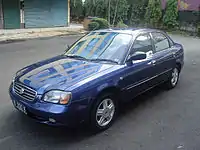Suzuki Cultus Crescent
The Suzuki Cultus Crescent (Japanese: スズキ カルタス クレセント, Suzuki Karutasu Kuresento) is a compact car that was produced by Suzuki in Japan between 1995 and 2002, with South Asian production continuing until 2007. The Cultus Crescent was sold as such in Japan until May 1998, when it was renamed Suzuki Cultus due to the sales discontinuation of the previous Cultus in the Japanese market. The Cultus Crescent was also marketed as the Suzuki Esteem in North America, and as the Suzuki Baleno throughout Asia, Australasia, Europe, South America, and Puerto Rico. In India where it was manufactured by Maruti Suzuki, the Cultus Crescent was sold as the Maruti Suzuki Baleno. In the Philippines, the facelift model was marketed as the Chevrolet Cassia.
| Suzuki Cultus Crescent (SY) | |
|---|---|
 1999–2000 Suzuki Esteem sedan (US) | |
| Overview | |
| Manufacturer | Suzuki |
| Also called |
|
| Production |
|
| Assembly |
|
| Body and chassis | |
| Class | Compact |
| Body style |
|
| Layout | Front engine, front-wheel drive / four-wheel drive |
| Powertrain | |
| Engine | |
| Transmission | |
| Dimensions | |
| Wheelbase |
|
| Length |
|
| Width |
|
| Height |
|
| Curb weight |
|
| Chronology | |
| Predecessor | Suzuki Cultus/Esteem/Swift |
| Successor | Suzuki Aerio/Liana/Baleno (sedan/wagon) Suzuki Swift/Ignis (hatchback) |
History

The Cultus Crescent was introduced in Japan in January 1995 and then to the global market in the first half of 1995. It was Suzuki's first attempt in the competitive compact segment. As a North American replacement for the Suzuki Cultus (Swift) sedan (the three-door hatchback remained after it was redesigned in 1995), it was built on a slightly stretched Cultus platform for improved cabin room, but otherwise sharing most of internal components with the smaller model—and marketed as a distinct model.
The Cultus Crescent was initially available as a three-door hatchback and four-door sedan, with the SOHC 16-valve G-family engine, in 1.3- and 1.5-liter form, with power ranging from 85 to 97 PS (63 to 71 kW). The 1.3-liter was only offered in the hatch while a 1.6-liter with 99 PS (73 kW) was only fitted to the sedan. Eventually, 4WD was offered with the 1.6-liter variant, basically the same engine as found in the Suzuki Escudo, with power raised to 115 PS (85 kW). A sports variant, dubbed GT, used Mazda's 1,840 cc BP engine, with 135 PS (99 kW). It was introduced in the spring of 1996, at the same time that the lineup was extended with the Baleno/Esteem Wagon (Maruti Baleno Altura in India).[1] This was Suzuki's first station wagon (excluding kei cars), also with the same 1.6-liter, which also received the optional four-wheel drive in the wagon. The Suzuki Esteem was introduced in the Philippines in 1996 and was sold until 2000, and was initially only available as a wagon. Suzuki then dropped the "Esteem" name in favor of Chevrolet, who had just been returning in the Philippine-market to have at least one sedan model to compete with other popular Japanese-made sedans.
1998 facelift

_GLX_station_wagon_(25838039680).jpg.webp)
Suzuki restyled the Cultus Crescent and renamed it Cultus (for the Japanese market only) in mid-1998. In North America, the changeover took place with the 1999 model year. The car was given a new front end, with a rounder grille and new headlights, and the engine lineup was expanded to include Suzuki's J18A chain-driven DOHC engine that was fitted to the sedan and wagon. In North America, the Esteem 1.8-liter wagon completely replaced the Esteem 1.6, but in most markets the 1.8 sedan became the sports model. In some European markets, the 1.8-liter was installed in the hatchback and sold as the limited edition Baleno GSR. The Suzuki 1.8 had exactly the same displacement as the earlier Mazda BP engine, but was less powerful with only 121 PS (89 kW; 119 hp) in European specifications.[2] Europe also gained a diesel version, with a 75 PS (55 kW; 74 hp) XUD9 engine supplied by Peugeot.
The Cultus was replaced in most markets by the new Aerio/Liana, which was launched in 2001.[3] In Japan, the sedan was discontinued in November 2001,[4] although the wagon remained until August 2002.[5] The entire range was pulled from the market in Europe and North America in 2002, after one year of overlapping with the Aerio/Liana. The car remained available in many developing countries, including India and Southeast Asia, where it was sold until 2007, when production stopped at the Maruti factory, with the assembly line giving way to the SX4 sedan.
In the Philippines, the facelift model was introduced in 2000 as the Chevrolet Cassia. Suzuki chose to drop the Esteem in the market in favor of Chevrolet Philippines, who have been re-introduced at that time to have an entry-level sedan competing against other Japanese-made sedans. Chevrolet's first sedan to be offered in the country for a new decade was not a market success. The 1.6 SOHC 16V 4-cylinder which made 96 horsepower was the only Engine choice offered and had fewer features than the rest of its rivals. Its main competitors were the Ford Lynx, Toyota Corolla, Honda Civic, Nissan Sentra, and the Mitsubishi Lancer. Due to poor sales, production ended in 2002, just 2 years after it was introduced. After it's discontinuation, the car was replaced by the Chevrolet Optra.
In popular culture
A yellow Suzuki Esteem (with one red door) is used as Jimmy McGill's car in the AMC TV show Better Call Saul.[6][7]
Gallery
 1995–1998 Suzuki Baleno hatchback (Germany)
1995–1998 Suzuki Baleno hatchback (Germany)%252C_front_right.jpg.webp) 1998–2001 Suzuki Baleno hatchback (Germany)
1998–2001 Suzuki Baleno hatchback (Germany) 1995–1998 Suzuki Baleno sedan (Germany)
1995–1998 Suzuki Baleno sedan (Germany) 1995–1998 Suzuki Baleno sedan (Germany)
1995–1998 Suzuki Baleno sedan (Germany).JPG.webp) 1998–2001 Suzuki Cultus sedan (Japan)
1998–2001 Suzuki Cultus sedan (Japan).JPG.webp) 1998–2002 Suzuki Cultus Wagon (Japan)
1998–2002 Suzuki Cultus Wagon (Japan) 2002 Suzuki Baleno sedan (Indonesia)
2002 Suzuki Baleno sedan (Indonesia)_GTX_sedan_(24062148255).jpg.webp) 1998 Suzuki Baleno GTX sedan
1998 Suzuki Baleno GTX sedan.jpg.webp) 2001 Suzuki Baleno GSR hatchback
2001 Suzuki Baleno GSR hatchback
References
- Nötzli, Max, ed. (7 March 2002). Automobil Revue 2002 (in German and French). 97. Berne, Switzerland: Büchler Grafino AG. p. 550. ISBN 3-905386-02-X.
- Automobil Revue 2002, p. 551
- "Suzuki Liana (Liana)". GoAuto. Retrieved 11 January 2011.
- スズキ カルタス 1989年7月(平成元年7月)〜2001年11月(平成13年11月) グレード一覧 [Suzuki Cultus grade list: July 1989 to November 2001]. Goo-net (in Japanese). Proto Corporation. Retrieved 11 January 2011.
- スズキ カルタスワゴン 1998年5月(平成10年5月)〜2002年8月(平成14年8月) グレード一覧 [Suzuki Cultus Wagon grade list: May 1998 to August 2002]. Goo-net (in Japanese). Proto Corporation. Retrieved 11 January 2011.
- George, Patrick (2015-10-02). "Better Call Saul's Crappy Suzuki Esteem Is An Inspired Choice". Jalopnik. Gizmodo.
- Henderson, Paul (2020-04-13). "The cars in Better Call Saul are perfect casting". GQ.
External links
 Media related to Suzuki Baleno at Wikimedia Commons
Media related to Suzuki Baleno at Wikimedia Commons- Suzuki Baleno XG, XT and Swift, All About Cars, 2016